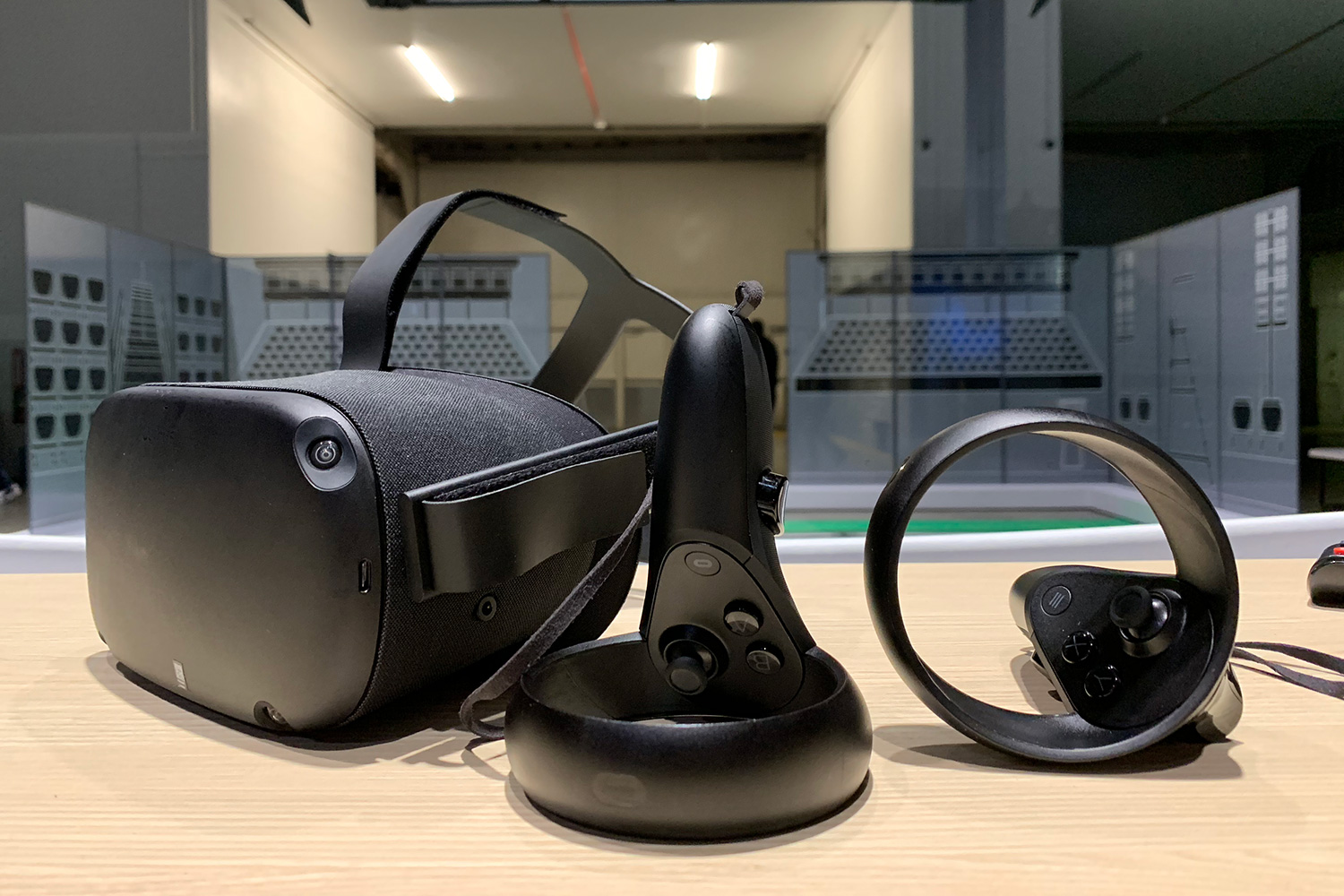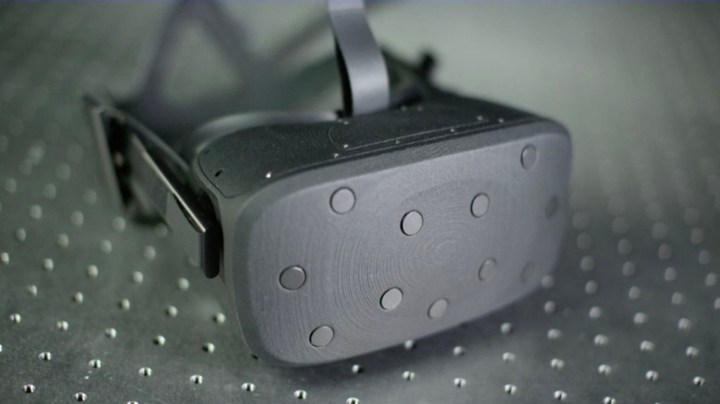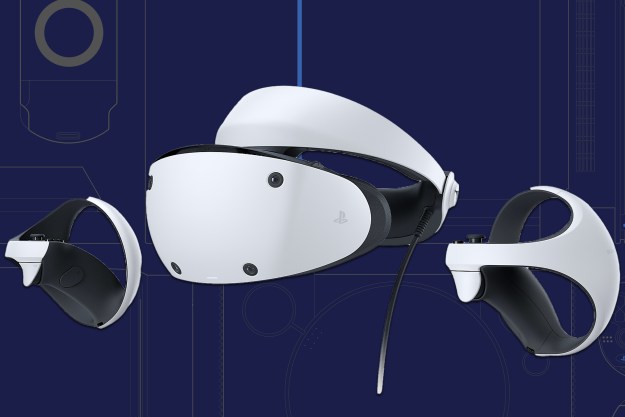
The Oculus Rift feels like it’s been around for a lot longer than it actually has. The VR headset was originally launched on Kickstarter back in 2012 — with its eventual consumer launch over two years ago in 2016. But with the launch of HTC’s Vive Pro earlier this year, you may be wondering when Oculus will launch its own version 2.0 of the Rift.
That’s not something we’ve heard much about, with Oculus instead focusing on more accessible VR headsets and most recently, the Oculus Quest. Unlike the original Rift, Oculus’ new VR headset is both cordless and stand-alone — making it feel like an altogether different type of headset. This shouldn’t be confused with the Oculus Go, which is a stand-alone but much more low-powered and affordable headset.
Confused? Don’t worry, here’s everything you need to know about the Oculus Quest.
The Oculus Quest headset

The Oculus Quest was originally teased in 2016 with an early prototype known as Project Santa Cruz. The goal was to use processors from “regular mobile computation” to achieve a wireless experience comparable to the wired Rift.
We tried it out at the time and were impressed, but the commercial iteration of the Oculus Quest that we tried at Oculus Connect 2018 was a much more complete product. It uses the company’s “Insight” tracking system, which utilizes four cameras for “inside-out” tracking. That means it doesn’t need external sensors to track users or their orientation, meaning they can move around and interact in VR without the need for any additional accessories at all.
It has full six-degrees of freedom movement, meaning you can walk around with it on and have your position accurately tracked. That’s a stark difference between this headset and the Oculus Go, which is limited to three degrees of freedom, or merely tilt and rotational tracking.
The handheld motion controllers are also tracked as long as they’re in view of the sensors. That means they can’t be tracked behind your back or when you’ve leaned in very close to something, but in our testing, we found it quite difficult to force the headset to lose track of them, so general use shouldn’t run into too many problems.
To make sure that wearers don’t bump into anything when walking around or waving their arms, Oculus uses its “Guardian” system that sets VR boundaries on the scanned space. It helps to keep people safe and warns them about any objects before they can bump into them.
Not quite PC-quality VR
Unlike the Oculus Go, which also cuts the cord to deliver a Gear VR-comparable experience, the Quest seeks to deliver higher-quality VR in a stand-alone package. To do so it features onboard graphics processing using a Qualcomm Snapdragon 835 — a noticeable improvement over the Go’s Snapdragon 821. It also has a built-in battery that we’re told will last between two and three hours.
As powerful as the new chip is, it’s still a far cry from the power of a dedicated gaming PC or laptop, meaning that the Quest will never look quite as good as the Oculus Rift in terms of detail. However, its images are certainly sharper with less of a screen-door effect, thanks to the use of higher-resolution displays. The Quest features twin OLED panels with a resolution of 1,600 × 1,440 per eye, equating to an overall resolution of 3,200 × 1,440.
Shaders, shadows, and textures won’t be PC-quality, but the overall experience is the closest we’ve yet seen to PC levels of detail in an untethered VR headset.
New Oculus Touch controllers

The Quest also comes with a lightly modified version of Oculus’ Touch controllers. Their tracking rings have been relocated to sit above the main palm grips, which makes them easier to track using the headset’s Insight system.
They maintain the same button, thumbstick, and grip layout as the original Touch design. There may be some more subtle changes under the skin, but for the most part they appear to be the original Touch controllers with some slight alterations for tracking purposes.
What about games?
The Oculus Quest will have its own library of titles when it debuts, which means it won’t easily slot into existing marketplaces designed with other headsets in mind. At this time there are a handful of compatible games and experiences, but Oculus promises at least 50 will be available when it becomes available to the public. VR developers may announce ports of their existing Rift games in the meantime, potentially leading to a greater catalog of titles further down the line.
When and how much?
The Oculus Quest might be ready for hands-on testing at show events like Oculus Connect, but it’s not quite ready for release just yet. Slated for a Spring 2019 release, it will be priced at $400 for the headset and two touch controllers.
What was left out?
The Oculus Quest isn’t Oculus’ last ever headset. It has been working on some other prototypes and ideas alongside it. Some of those features may have been dropped entirely, while others may still be relevant for future iterations of Oculus’ headsets, be that second generations of devices like the Go, Quest, or Oculus Rift.
The “Half Dome” prototype

At the Facebook F8 developer conference in 2018, we saw another Quest-like prototype under the name “Half Dome.” That prototype had a leaner, more compact design than the earlier version we saw, and several very interesting new features.
First, the Half Dome introduced varifocal lenses, which autofocused the VR images separately to appear more realistic to the eye, basically imitating the way that your eyes focus on objects at the center of your vision while the corners are a bit blurry. This is a promising development for VR headsets, because it can help solve motion blur issues and may reduce the nausea that some people experience in VR environments, especially when trying to examine closer objects. However, it requires advanced software that wasn’t available with the original Rift.
The prototype also showed off a wider field of view than the original Rift, up from 110 degrees to 140 degrees. This includes all of your peripheral vision, and when combined with the varifocal display, can offer a more immersive experience.
Advanced VR controls
Oculus has some other interesting control technology in the works. We’ve found patent filings that Oculus has made for a set of VR gloves that use haptic feedback for a more realistic experience. According to the patent, “The haptic feedback mechanism includes a composite extendible ribbon coupled to a glove digit of a glove body. The glove digit is configured to be work around a [finger] of a user’s hand…The haptic feedback facilitates an illusion that a user is interacting with a real object when in fact the object is a virtual object.”
These gloves are being developed alongside a related Oculus project that is even mimics how our skin moves. It sounds creepy, but it just means these gloves are intended to calibrate themselves via users lifting real-world objects, so they can stretch and compress in the right ways to mimic the experience. This could potentially make digital objects feel real.
So, where is the Oculus Rift 2?
Oculus has spent much of the past two years improving VR’s accessibility instead of focusing on the high-end experiences. That will likely change soon. In a blog post, Oculus VR stated that, “With the introduction of Oculus Quest, we’ve completed our first generation of best-in-class VR headsets.” That may mean that the next headset we see from the company will be a Rift 2, followed by new-generation examples of other headsets like the Go and Quest further down the line.
That doesn’t give us a solid idea of when a new-generation Rift will be released, but it suggests we will see it in the near future. We still expect PC connectivity with it, to drive class-leading visuals, but it will likely adopt wireless connectivity as we’ve seen with the HTC Vive and third-party add-on modules. The “half-dome” prototype could certainly be using some technology that could be implemented in Oculus’ next Rift headset too, but we’ll have to wait and see if that turns out to be true.
Editors' Recommendations
- Stardew Valley 1.6 update: everything you need to know
- The best games on Meta Quest 3
- The best Meta Quest 2 games
- Nvidia RTX DLSS: everything you need to know
- What is Twitch? Everything you need to know about the top live-streaming platform




